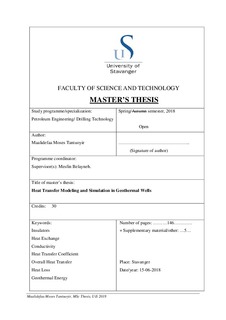| dc.contributor.advisor | Belayneh, Mesfin Agonafir | |
| dc.contributor.author | Tantuoyir, Maalidefaa Moses | |
| dc.date.accessioned | 2018-10-29T10:19:44Z | |
| dc.date.available | 2018-10-29T10:19:44Z | |
| dc.date.issued | 2018-06-15 | |
| dc.identifier.uri | http://hdl.handle.net/11250/2569914 | |
| dc.description | Master's thesis in petroleum engineering | nb_NO |
| dc.description.abstract | Geothermal energy is among the fastest growing renewable energies. In the field of geothermal, energy conversion refers to the power plant technology that converts the hot geothermal fluids into electric power. The two primary sources of geothermal energy are hydrothermal resources mainly found at shallower depth and hot dry rock resources normally found in a deeper formation.
The higher the energy extraction, the better for the power plant energy conversion. However, in poorly designed wellbore, the up flowing geothermal fluid induces a radial heat flux from the well toward the rock. Because of heat transfer, the surface temperature will be reduced and will not be sufficient for the power plant energy conversion. To maintain/preserve heat transfer, it is therefore important to design a well with appropriate material and identify the right operational parameters.
In this thesis, inner insulator was included in the production tube/casing to develop a heat transfer analytical model with the objective of significantly reducing heat loss from the reservoir to the surface, reduce the effect of corrosion and erosion of production casing/tubing and predict the effect of high flow rate on heat transfer in hard-rock geothermal wells. Several case scenario have been simulated with analytical model and with commercial Landmark / WELLCAT software.
Results showed that high flowrate leads to low heat loss to the formation, placing an inner insulator in the production casing conserves heat produced from the reservoir to the surface as compared to placing on an outer insulator, thermal conductivity of cement is insignificant when the value is above 1 [BTU/hr-ft-ºF] and the thermal conductivity of casings is significant when the well is completed without insulators. | nb_NO |
| dc.language.iso | eng | nb_NO |
| dc.publisher | University of Stavanger, Norway | nb_NO |
| dc.relation.ispartofseries | Masteroppgave/UIS-TN-IEP/2018; | |
| dc.subject | geothermal energy | nb_NO |
| dc.subject | petroleumsteknologi | nb_NO |
| dc.subject | petroleum technology | nb_NO |
| dc.subject | insulators | nb_NO |
| dc.subject | heat exchange | nb_NO |
| dc.subject | conductivity | nb_NO |
| dc.subject | heat transfer coefficient | nb_NO |
| dc.subject | overall heat transfer | nb_NO |
| dc.subject | heat loss | nb_NO |
| dc.title | Heat Transfer Modeling and Simulation in Geothermal Wells | nb_NO |
| dc.type | Master thesis | nb_NO |
| dc.subject.nsi | VDP::Teknologi: 500::Berg‑ og petroleumsfag: 510::Petroleumsteknologi: 512 | nb_NO |
